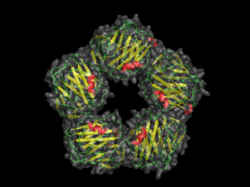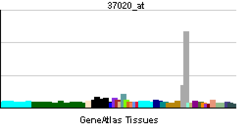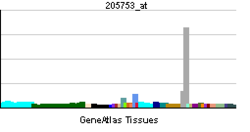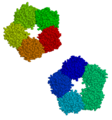C-reactive protein
| edit |
| C-reactive protein, pentraxin-related | |||||||||||||
|---|---|---|---|---|---|---|---|---|---|---|---|---|---|
 CRP drawn from PDB 1B09 |
|||||||||||||
|
|||||||||||||
| Identifiers | |||||||||||||
| Symbols | CRP; MGC149895; MGC88244; PTX1 | ||||||||||||
| External IDs | OMIM: 123260 MGI: 88512 HomoloGene: 476 GeneCards: CRP Gene | ||||||||||||
|
|||||||||||||
| RNA expression pattern | |||||||||||||
 |
|||||||||||||
 |
|||||||||||||
| More reference expression data | |||||||||||||
| Orthologs | |||||||||||||
| Species | Human | Mouse | |||||||||||
| Entrez | 1401 | 12944 | |||||||||||
| Ensembl | ENSG00000132693 | ENSMUSG00000037942 | |||||||||||
| UniProt | P02741 | Q542I3 | |||||||||||
| RefSeq (mRNA) | NM_000567 | NM_007768 | |||||||||||
| RefSeq (protein) | NP_000558 | NP_031794 | |||||||||||
| Location (UCSC) | Chr 1: 157.95 - 157.95 Mb |
Chr 1: 174.53 - 174.54 Mb |
|||||||||||
| PubMed search | [2] | [3] | |||||||||||
C-reactive protein (CRP) is a protein found in the blood, the levels of which rise in response to inflammation (an acute-phase protein). Its physiological role is to bind to phosphocholine expressed on the surface of dead or dying cells (and some types of bacteria) in order to activate the complement system via the C1Q complex[1].
CRP is synthesized by the liver[2] in response to factors released by fat cells (adipocytes).[3] It is a member of the pentraxin family of proteins.[2] It is not related to C-peptide or protein C.
Contents |
History and nomenclature
CRP was originally discovered by Tillett and Francis in 1930 as a substance in the serum of patients with acute inflammation that reacted with the C polysaccharide of pneumococcus.[4] Initially it was thought that CRP might be a pathogenic secretion as it was elevated in people with a variety of illnesses including cancer,[2] however discovery of hepatic synthesis demonstrated that it is a native protein.
Genetics and biochemistry
The CRP gene is located on the first chromosome (1q21-q23). CRP is a 224-residue protein[5] with a monomer molar mass of 25106 Da. The protein is an annular pentameric disc in shape and a member of the small pentraxins family.
Function
CRP is a member of the class of acute-phase reactants, as its levels rise dramatically during inflammatory processes occurring in the body. This increment is due to a rise in the plasma concentration of IL-6, which is produced predominantly by macrophages[2] as well as adipocytes.[3] CRP binds to phosphocholine on microbes. It is thought to assist in complement binding to foreign and damaged cells and enhances phagocytosis by macrophages (opsonin mediated phagocytosis), which express a receptor for CRP. It is also believed to play another important role in innate immunity, as an early defense system against infections.
CRP rises up to 50,000-fold in acute inflammation, such as infection. It rises above normal limits within 6 hours, and peaks at 48 hours. Its half-life is constant, and therefore its level is mainly determined by the rate of production (and hence the severity of the precipitating cause). Serum amyloid A is a related acute-phase marker that responds rapidly in similar circumstances.[2]
Diagnostic use
CRP is used mainly as a marker of inflammation. Apart from liver failure, there are few known factors that interfere with CRP production.[2]
Measuring and charting CRP values can prove useful in determining disease progress or the effectiveness of treatments. Blood, usually collected in a serum-separating tube, is analysed in a medical laboratory or at the point of care. Various analytical methods are available for CRP determination, such as ELISA, immunoturbidimetry, rapid immunodiffusion, and visual agglutination.
A high-sensitivity CRP (hs-CRP) test measures low levels of CRP using laser nephelometry. The test gives results in 25 minutes with a sensitivity down to 0.04 mg/L. Normal concentration in healthy human serum is usually lower than 10 mg/L, slightly increasing with ageing. Higher levels are found in late pregnant women, mild inflammation and viral infections (10–40 mg/L), active inflammation, bacterial infection (40–200 mg/L), severe bacterial infections and burns (>200 mg/L).[6]
Cardiology diagnostic test
Arterial damage results from white blood cell invasion and inflammation within the wall. CRP is a general marker for inflammation and infection, so it can be used as a very rough proxy for heart disease risk. Since many things can cause elevated CRP, this is not a very specific prognostic indicator.[7] Nevertheless, a level above 2.4 mg/l has been associated with a doubled risk of a coronary event compared to levels below 1 mg/l[2]; however, the study group in this case consisted of patients who had been diagnosed with unstable angina pectoris; whether elevated CRP has any predictive value of acute coronary events in the general population of all age ranges remains unclear.
Role in cardiovascular disease
Recent research suggests that patients with elevated basal levels of CRP are at an increased risk of diabetes,[8][9] hypertension and cardiovascular disease. A study of over 700 nurses showed that those in the highest quartile of trans fat consumption had blood levels of CRP that were 73% higher than those in the lowest quartile.[10] Although one group of researchers indicated that CRP may only be a moderate risk factor for cardiovascular disease,[11] this study (known as the Reykjavik Study) was found to have some problems for this type of analysis related to the characteristics of the population studied, and there was an extremely long follow-up time, which may have attenuated the association between CRP and future outcomes.[12] Others have shown that CRP can exacerbate ischemic necrosis in a complement-dependent fashion and that CRP inhibition can be a safe and effective therapy for myocardial and cerebral infarcts; so far, this has been demonstrated only in animal models.[13]
The JUPITER trial was conducted to determine if patients with elevated CRP levels but without hyperlipidemia might benefit from statin therapy. Statins were selected because they have been proven to reduce levels of CRP. The trial found that patients taking rosuvastatin with elevated CRP levels experienced a decrease in the incidence of major cardiovascular events.[14] The trial specifically found, "the number of patients who would need to be treated with rosuvastatin for 2 years to prevent the occurrence of one primary end point is 95, and the number needed to treat for 4 years is 31." In other words, after four years of treatment, out of every 31 patients, one cardiovascular event would be prevented.
To clarify whether CRP is a bystander or active participant in atherogenesis, a 2008 study compared people with various genetic CRP variants. Those with a high CRP due to genetic variation had no increased risk of cardiovascular disease compared to those with a normal or low CRP.[15]
CRP is associated with lipid responses to low-fat and high-polyunsaturated fat diets.[16]
Role in cancer
The role of inflammation in cancer is not well known. Some organs of the body show greater risk of cancer when they are chronically inflamed.
Blood samples of persons with colon cancer have an average CRP concentration of 2.69 milligrams per liter. Persons without colon cancer average 1.97 milligrams per liter. The difference was statistically significant.[17] These findings concur with previous studies that indicate that anti-inflammatory drugs could lower colon cancer risk.[18]
See also
- acute phase
- erythrocyte sedimentation rate
- immunology
Additional images
 C-reactive protein |
References
- ↑ Thompson D, Pepys MB, Wood SP. (1999). "The physiological structure of human C-reactive protein and its complex with phosphocholine.". Structure 7 (2): 169–77. doi:10.1016/S0969-2126(99)80023-9. PMID 10368284.
- ↑ 2.0 2.1 2.2 2.3 2.4 2.5 2.6 Pepys MB, Hirschfield GM (2003). "C-reactive protein: a critical update". J Clin Invest 111 (12): 1805–12. doi:10.1172/JCI18921. PMID 12813013. PMC 161431. http://www.jci.org/articles/view/18921. Full text at PMC: 161431
- ↑ 3.0 3.1 Lau DC, Dhillon B, Yan H, Szmitko PE, Verma S (2005). "Adipokines: molecular links between obesity and atheroslcerosis". Am J Physiol Heart Circ Physiol 288 (5): H2031–41. doi:10.1152/ajpheart.01058.2004. PMID 15653761. http://ajpheart.physiology.org/cgi/content/full/288/5/H2031.
- ↑ Tillett WS, Francis Jr T (1930). "Serological reactions in pneumonia with a nonprotein somatic fraction of pneumococcus" (PDF). J Exp Med 52: 561–585. doi:10.1084/jem.52.4.561. http://www.jem.org/cgi/reprint/52/4/561.
- ↑ NCBI Entrez Protein #CAA39671
- ↑ Clyne, Brian; Jonathan S. Olshaker (1999). "The C-reactive protein". Journal of Emergency Medicine 17 (6): 1019–1025. doi:10.1016/S0736-4679(99)00135-3. ISSN 0736-4679. PMID 10595891. http://www.sciencedirect.com/science/article/B6T8B-3XWJKJJ-M/2/2652c1252d09f3e3fdb1cf8914878c5f. Retrieved 2009-09-24.
- ↑ Lloyd-Jones DM, Liu K, Tian L, Greenland P (5 June 2006). "Narrative review: assessment of C-reactive protein in risk prediction for cardiovascular disease". Ann Intern Med 145 (1): 35–42. PMID 16818927. http://annals.org/cgi/content/full/0000605-200607040-00129v1.
- ↑ Pradhan AD; Manson, JE; Rifai, N; Buring, JE; Ridker, PM (2001). "C-reactive protein, interleukin 6, and risk of developing type 2 diabetes mellitus". JAMA 286 (3): 327–334. doi:10.1001/jama.286.3.327. PMID 11466099. http://www.ncbi.nlm.nih.gov/entrez/query.fcgi?CMD=search&DB=pubmed.
- ↑ Dehghan A; Kardys, I; De Maat, MP; Uitterlinden, AG; Sijbrands, EJ; Bootsma, AH; Stijnen, T; Hofman, A et al. (2007). "Genetic variation, C-reactive protein levels, and incidence of diabetes". Diabetes 56 (3): 872. doi:10.2337/db06-0922. PMID 17327459.
- ↑ Esther Lopez-Garcia; Schulze, MB; Meigs, JB; Manson, JE; Rifai, N; Stampfer, MJ; Willett, WC; Hu, FB (1 March 2005). "Consumption of trans fatty acids is related to plasma biomarkers of inflammation and endothelial dysfunction". Journal of Nutrition 135 (3): 562–566. PMID 15735094. http://jn.nutrition.org/cgi/content/full/135/3/562.
- ↑ John Danesh; Wheeler, JG; Hirschfield, GM; Eda, S; Eiriksdottir, G; Rumley, A; Lowe, GD; Pepys, MB et al. (2004). "C-reactive protein and other circulating markers of inflammation in the prediction of coronary heart disease". New England Journal of Medicine 350 (14): 1387–1397. doi:10.1056/NEJMoa032804. PMID 15070788.
- ↑ Koenig, Wolfgang (2006). C-reactive protein – a critical cardiovascular risk marker [1]
- ↑ Pepys MB, Hirschfield GM, Tennent GA, Gallimore JR, Kahan MC, Bellotti V, Hawkins PN, Myers RM, Smith MD, Polara A, Cobb AJ, Ley SV, Aquilina JA, Robinson CV, Sharif I, Gray GA, Sabin CA, Jenvey MC, Kolstoe SE, Thompson D, Wood SP (2006). "Targeting C-reactive protein for the treatment of cardiovascular disease". Nature 440 (7088): 1217–1221. doi:10.1038/nature04672. PMID 16642000.
- ↑ Ridker PM, Danielson E, et al. (November 2008). "Rosuvastatin to prevent vascular events in men and women with elevated C-reactive protein". N. Engl. J. Med. 359 (21): 2195–207. doi:10.1056/NEJMoa0807646. PMID 18997196.
- ↑ Zacho J, Tybjaerg-Hansen A, Jensen JS, Grande P, Sillesen H, Nordestgaard BG (October 2008). "Genetically elevated C-reactive protein and ischemic vascular disease". N Engl J Med 359 (18): 1897–908. doi:10.1056/NEJMoa0707402. PMID 18971492.
- ↑ http://jn.nutrition.org/cgi/content/abstract/139/4/680
- ↑ Erlinger TP, Platz EA, Rifai N, Helzlsouer KJ (2004). "C-reactive protein and the risk of incident colorectal cancer". Journal of the American Medical Association 291 (Feb. 4): 585–590. doi:10.1001/jama.291.5.585. PMID 14762037.
- ↑ Baron JA, et al. (2003). "A randomized trial of aspirin to prevent colorectal adenomas". New England Journal of Medicine 348 (10): 891–899. doi:10.1056/NEJMoa021735. PMID 12621133.
External links
- MedlinePlus Encyclopedia C-reactive protein
- Inflammation, Heart Disease and Stroke: The Role of C-Reactive Protein (American Heart Association)
- MeSH C-Reactive+Protein
|
|||||||||||||||||||||||||||||||||
|
||||||||||||||||||||
|
|||||||||||||||||||||||||||||||||||||||||||
